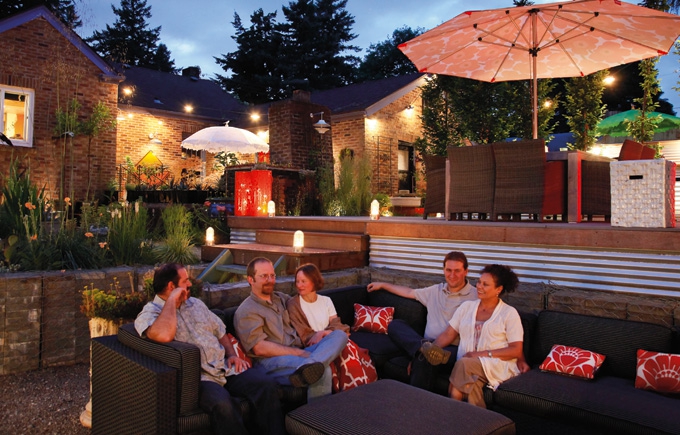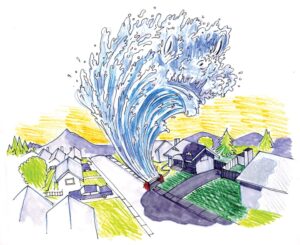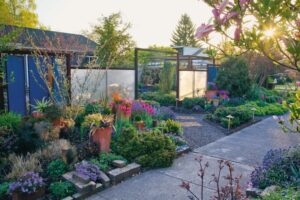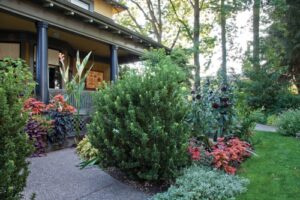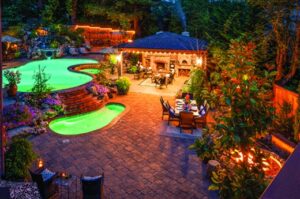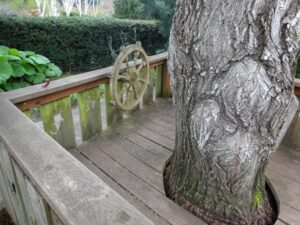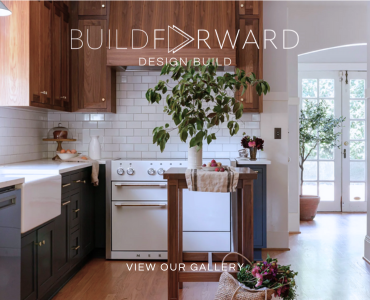Above: Guests congregate with Jose De Sousa (far left) in the lower-level living room. Candles and house lights project a warm aura illuminating the garden at twilight // Photos by Joshua McCullough
JJ De Sousa is a party girl, and nowhere is her penchant for entertaining more apparent than in her garden. Her background in interior design and her flair for garden design meld in a space where contrasts abound. The old world architecture of her circa 1924 English cottage in Portland juxtaposed with contemporary materials speaks volumes about her design aesthetic and the way she approaches creating chic outdoor living spaces.
Childhood memories of family gardens in Holland and Belgium, where she lived part time until she was 15, coupled with an interest in repurposing found objects, architectural salvage and industrial materials imbue the garden with a sense of her personal style and energy. The lines between house and garden are blurred as the garden is laid out in a series of interconnected rooms, each with a specific function or purpose.
When she purchased the ramshackle English cottage on the flanks of Mt. Tabor in 1996, gardening was the furthest thing from her mind. She despised pulling weeds for her mother in high school and didn’t want to be a gardener. But what captivated De Sousa was the opportunity to breathe new life into the house, a rental complete with a squatter in the basement, no running water or electricity and a condemnation order from the city. Undaunted, she bought the house and began the ongoing process of remodeling.
Once renovation on the cottage was under way, she forced herself to consider the derelict condition of the garden. The area behind the house resembled an archaeological dig. Stone walls, staircases and terraces installed 60 years ago were partially destroyed and slumping, the soil was depleted and old plants were out of control. De Sousa says joining the Hardy Plant Society of Oregon and going to lectures, open gardens and plant sales gave her the impetus and information to begin garden making. She turned out to be a quick study.
The first iteration of the garden was focused on plants rather than hardscape and proved to be too labor and time intensive. What became clear to De Sousa, who owns interior/exterior design firm Digs Inside & Out in Portland, and her husband, Jose, was that while the garden was pretty in a traditional sense, it didn’t reflect their personalities or lifestyle.
They wanted the garden to function like a house with spaces to cook, eat, relax, nap, entertain and hang out. It was clear to them that the way to accomplish their goals was to reverse roles in the space. Terraces, walkways, furniture and structures would become the focal points while plants would be made more manageable, require less maintenance and contribute to the scene year-round.
Donning what she calls her “Dutch minimalist hat,” De Sousa went back to the drawing board and made the space feel larger by breaking it down into a series of smaller, intimate spaces. In the living room, on the lowest level of the garden, a large sectional sofa, chairs and a coffee table beckon. Two sides of the space are defined by gabions that Jose built. Instead of being filled with randomly sized rocks, the way they are for highway projects, he wrapped concrete pavers in a steel grid for a geometric, urban vibe. Gravel, which De Sousa likes because it helps drainage, is the surfacing material in this part of the garden. A metal staircase salvaged from a defunct factory rises to the upper garden, linking the changes in grade.
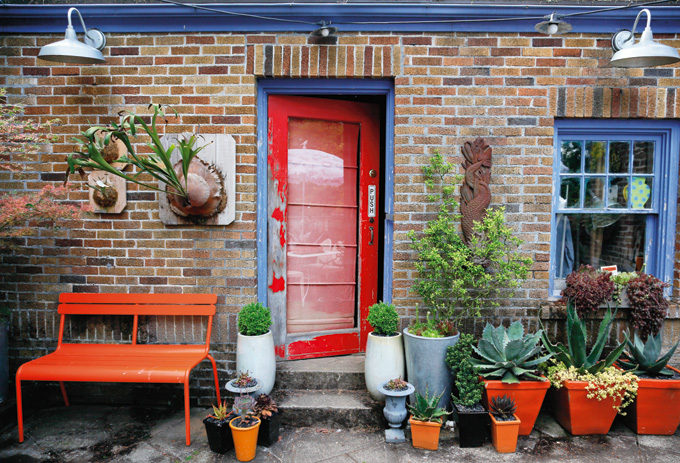 |
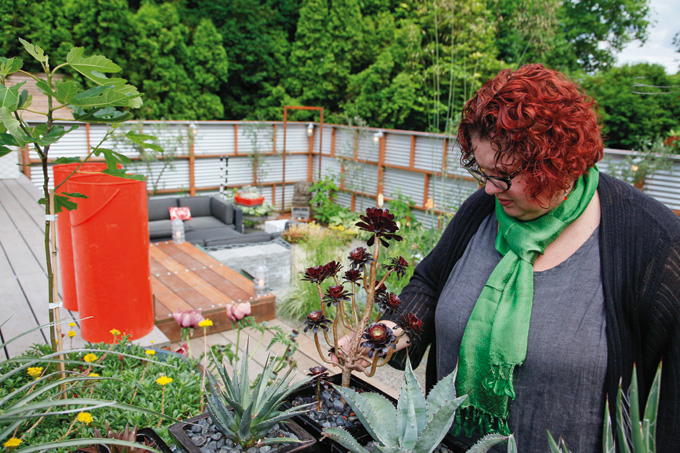 |
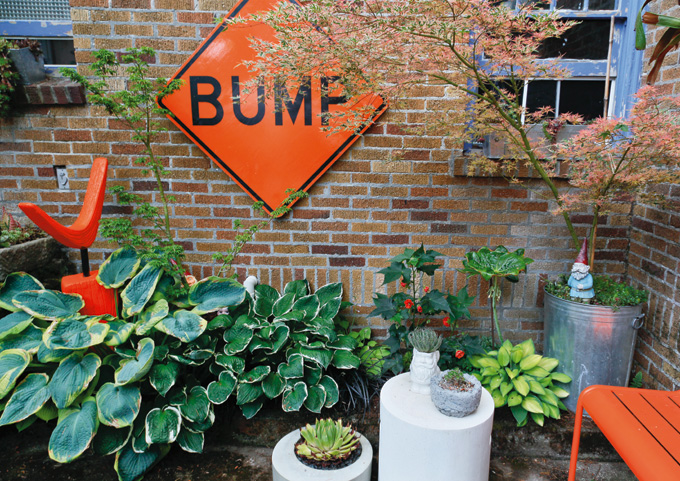 |
|
A fiery orange bench and pots grouped around the back door contrast with the crimson door and Wedgwood-blue trim evoking the spirit of a European village. |
Aeonium ‘Zwartkop,’ a dramatic succulent with purple/black rosettes, captures JJ De Sousa’s attention. Planted in a container, it’s easy to move into the greenhouse during the winter. |
A repurposed road sign is a humourous focal point on the back wall of the house. // Photos by Joshua McCullough |
The alfresco dining room deck floats across the central portion of the space. It was less expensive to build the new deck right over the top of the old stonework than to remove it. A large dining table and comfortable chairs invite guests to linger after a meal. Subtle night lighting adds to the ambience. Palm trees in oversize containers are a sassy addition to this tailored space.
The vivid print on a Marimekko umbrella casts shade over the table while radiating hot colors out into the garden. Jolts of red, orange and magenta pop when used against the neutral background of gray gravel, black decking and brick. Shiny, reflective panels of corrugated sheet metal face the front of the shed and are used for fencing in the lower garden.
A short row of pleached hornbeams separate the dining room from the lounge. The deciduous trees offer varying degrees of transparency throughout the seasons. In full leaf they screen the view, while allowing plenty of light in the space when they shed their leaves in the fall. A recycled orange enamel fireplace anchors the space. Pistachio-colored chairs and tangerine loungers are tempting places to relax, snooze or watch the fire. A new shed and a greenhouse are located in the utility area.
“A garden doesn’t have to be big to feel big,” says De Sousa. This once reluctant gardener has proven just that with her bold, exuberant blending of home and garden to create a vibrant outdoor living space.
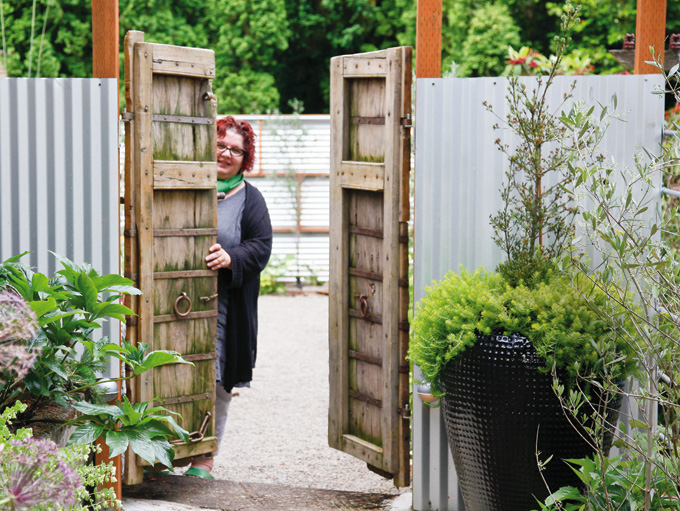 |
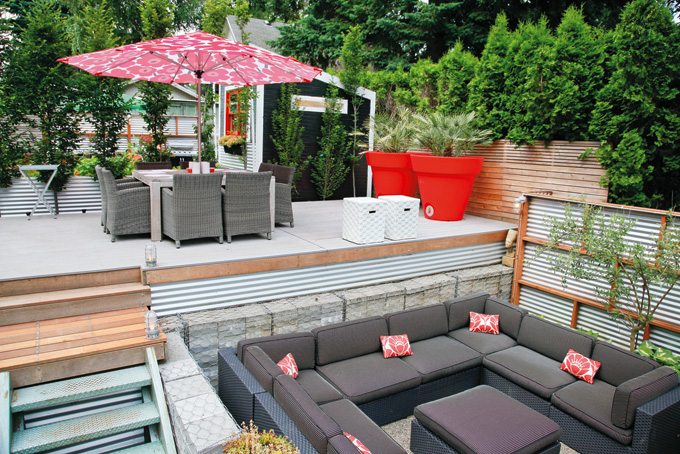 |
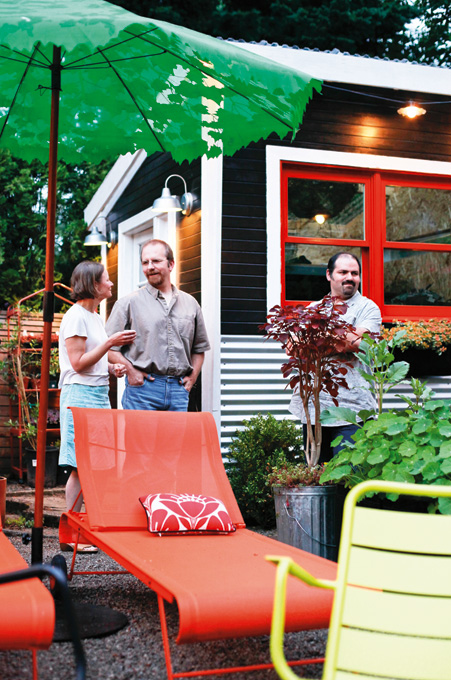 |
|
The patina of a Tibetan gate and the brashness of corrugated sheet metal define the entry into the back garden from the side yard. |
The dining room is the focal point of the garden. De Sousa uses vivid colors against a neutral background to define and connect all the outdoor rooms. |
A green umbrella hovers over the lounge area. The shed defines one “wall,” and the orange window trim is the visual connection to the lounge chairs. // Photos by Joshua McCullough |
Open-air tips
- Furnishings and accessories don’t have to be expensive — think about new ways to use found objects. Big-box stores carry knock-offs of trendy outdoor furniture.
- Create conversation areas by clustering chairs and small tables.
- Portable fire pits and bowls add warmth and charm to outdoor settings.
- Use potted plants, not cut flowers. Less work, longer-lasting.
- Think big when designing patios and terraces. Leave plenty of space for tables and chairs.
- Use outdoor lighting discretely. White holiday twinkle lights are enchanting threaded through small trees and large shrubs.
- Chairs don’t need to match, but it’s important to provide ample seating for guests. Colorful folding chairs are easy to store.
- Buy bigger containers than you think you need. Drama is good.



